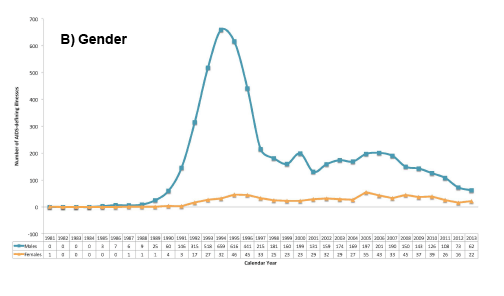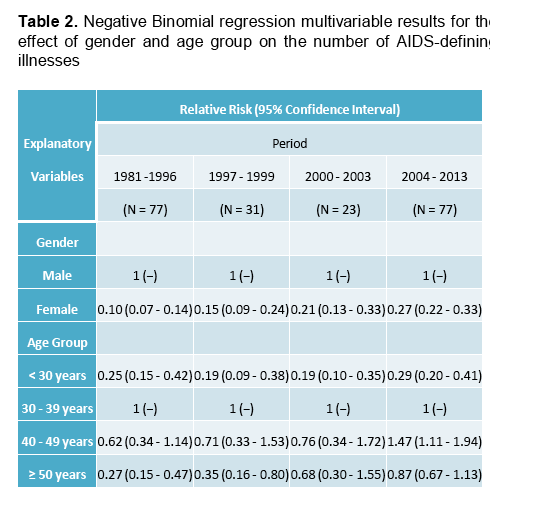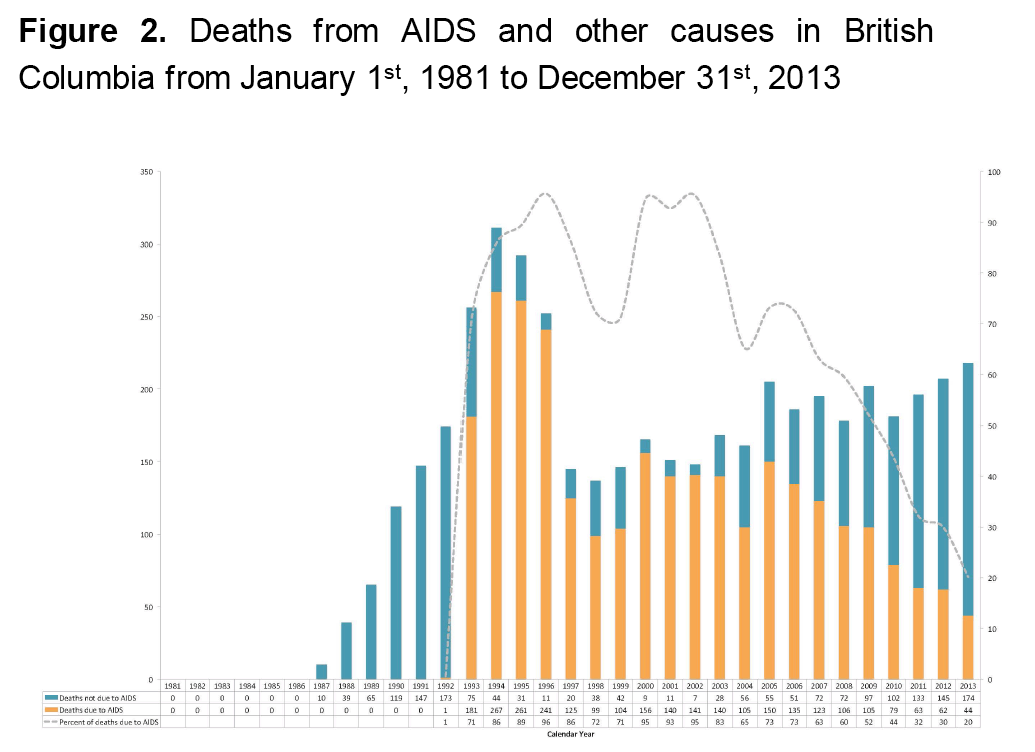 |
 |
 |
| |
Mortality Steady and Non-AIDS Deaths Rising in British Columbia Since 2005
|
| |
| |
IAS 2015, July 19-22, 2015, Vancouver
Mark Mascolini
New AIDS diagnoses and AIDS deaths plunged in British Columbia after 1994, as combination antiretroviral therapy took hold [1]. But mortality in HIV-positive people has remained constant in the province since 2005, and the proportion of non-AIDS deaths versus AIDS death began growing steadily in that year.
To chart trends in AIDS diagnoses and mortality, researchers from the British Columbia Centre for Excellence in HIV/AIDS tapped four administrative databases. The analyses included HIV-positive people 19 or older with data on AIDS-defining illnesses or mortality. Follow-up continued from January 1981 to December 2013, last contact date, or death, whichever came first. The BC team used a negative binomial model to estimate the relative risk of an AIDS illness over time. They used generalized additive models to explore trends in the percentage of deaths caused by AIDS. The researchers published their findings in Lancet HIV before IAS 2015 [2].
Of the 3550 people studied for AIDS diagnoses, 3097 (87%) were men and 453 women. Age at first AIDS illness averaged 41. The researchers recorded 6205 AIDS illnesses, and each person had an average of two AIDS illnesses. The AIDS illness rate peaked in 1994 with 42 diagnoses per 100 person-years, meaning 42 of every 100 people got an AIDS diagnosis per year. That rate plummeted to 7 per 100 person-years in 1997 and to 1 per 100 person-years in 2013 (P < 0.0001 for trend).
Men shouldered a much heavier burden of AIDS diagnoses throughout the study period, but the proportion of AIDS diagnoses in men versus women began shrinking from 1991 (49 to 1), to 1996 (10 to 1), all the way to 2013 (3 to 1). In 1981-1996 the relative risk of an AIDS diagnosis was 90% lower in women than men. That relative risk waned to 85% lower in 1997-1999, to 79% lower in 2000-2003, and to 73% lower in 2004-2013.
The British Columbia AIDS epidemic has also shifted in age. Before 2004 the epidemic was concentrated in 30-to-39-year olds, but since then 40-to-49-year-olds and most recently 50-and-older people have accounted for the highest proportion of AIDS diagnoses in British Columbia. In 2013 the most frequent AIDS diagnoses were wasting (8), non-Hodgkin lymphoma (7), TB (4), candidiasis (4), and dementia (3).
The mortality analysis focused on 4654 HIV-positive people who died of any cause during the study period. The investigators charted an overall death rate of 4 per 100 person-years, with 61% of those deaths attributed to AIDS. They could assign death to AIDS or non-AIDS causes starting in 1992. Since then overall mortality fell from 19 per 100 person-years in 1994 to 3 per 100 person-years in 2013. During that period the BC team recorded two peaks during which AIDS accounted for 80% or more deaths--from 1994 through 1996 and from 2000 through 2003.
Overall mortality has remained constant since 2005, but after 2005 the proportion of deaths caused by AIDS declined steadily, from 73% (2 per 100 person-years) in 2005 to 20% (0.6 per 100 person-years) in 2013. Thus non-AIDS causes of death accounted for 27% of deaths in 2005 and for 80% in 2013.
The researchers believe their findings "strengthen the evidence that programmes that aggressively distribute free ART to infected individuals have great potential to decrease morbidity and mortality caused by AIDS." They proposed that "diminishing the effect of AIDS in those living with HIV will require not only lifetime access to ART, but also a combination of different strategies to minimise leakage along the HIV continuum of care."
References
1. Lima VD, Lourenco L, Yip B, Hogg R, Phillips P, Montaner JSG. Trends in AIDS incidence and AIDS-related mortality in British Columbia between 1981 and 2013. IAS 2015. 8th Conference on HIV Pathogenesis, Treatment and Prevention. July 19-22, 2015. Vancouver. Abstract WEPEC596. http://pag.ias2015.org/PAGMaterial/eposters/1388.pdf
2. Lima VD, Lourenco L, Yip B, Hogg RS, Phillips P, Montaner JS. Trends in AIDS incidence and AIDS-related mortality in British Columbia between 1981 and 2013. Lancet HIV. 2015;2:e92-e97.
--------------------
Reported by Jules Levin

Trends in AIDS incidence and AIDS-related mortality in British Columbia between 1981-2013
Viviane D. Lima PhD,1,2 Lillian Louren¨o MPH,1 Benita Yip BSc Pharm.,1 Robert S. Hogg PhD,1,3 Peter Phillips MD,1,4 and Julio S.G. Montaner MD1,2
1. British Columbia Centre for Excellence in HIV/AIDS, St. PaulÕs Hospital, Vancouver, British Columbia, Canada. 2. Division of AIDS, Department of Medicine, Faculty of Medicine, University of British Columbia, Vancouver, British Columbia, Canada. 3. Faculty of Heath Sciences, Simon Fraser University, Burnaby, British Columbia, Canada. 4. Division of Infectious Diseases, University of British Columbia, Vancouver, BC, Canada.






|
| |
|
 |
 |
|
|